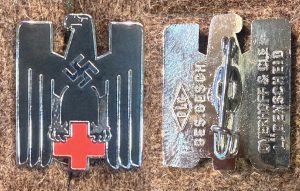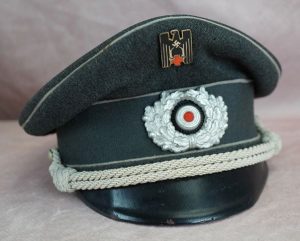WWII German Red Cross DRK Deutsches rotes kreuz visor cap eagle
$15.00
1 in stock
WWII German Red Cross DRK Deutsches rotes kreuz visor cap eagle, approx 28mm tall. This pin is nicely marked with the Ges. Gesch and the OLC Overhoff cie Ludenscheid makers mark. Visor hat in photo not included, just a reference for eagle size.
In April 1933, Nazi Reich Interior Minister Wilhelm Frick made it clear to Winterfeldt-Mencken that the focus on social welfare was over; the DRK would be expected to play its part in supporting the German armed forces in any future conflict. Shortly after, the DRK was informed that Dr. Paul Hocheisen, head of the SS Medical Corps, had been given responsibility for voluntary nursing organizations.
The DRK was quick to respond to the changed circumstances, as Winterfeldt-Mencken had always been opposed to parliamentary democracy. The Workers’ Samaritan League, a left-wing humanitarian organization, had always been an unwelcome competitor to the DRK. Hocheisen quickly arranged for it to be taken over by the DRK. Similarly, the DRK quickly moved to rid itself of left-wing members, and in June 1933, decided to apply the Nazi Law for the Restoration of the Professional Civil Service, and dismissed its Jewish employees.
However, the DRK was still a member of the Red Cross movement, and Germany remained a signatory to the Geneva Convention, so the German Red Cross could not apply the same level of Gleichschaltung, or Nazification, as other organizations. The attitude of the International Committee of the Red Cross (ICRC) towards the DRK exclusion of Jews was later expressed in a 1939 letter by ICRC President Max Huber. According to him, the primary obligation of neutral treatment as foreseen in the Geneva Convention was to victims of war, not to the helpers. Huber argued that as it was impossible to prescribe rules in conflict with national laws, and that it was better to take a flexible approach than risk breaking up the international Red Cross movement.
Winterfeldt-Mencken’s professions of loyalty to the regime were not reciprocated; the Nazi leadership sought to have him replaced with Hocheisen. German President Paul von Hindenburg was able to influence the decision, instead selecting Charles Edward, Duke of Saxe-Coburg and Gotha, Queen Victoria’s grandson. Charles Edward had moved from England to Germany at the age of 15, had subsequently served as a German army general in World War I, and had long supported right-wing movements in general, and Hitler in particular. He was already honorary president of the National Socialist Motor Corps.
Charles Edward became DRK President in December 1933, and Hocheisen became his deputy. Not unsurprisingly, the two did not work well together. There followed a typically Nazi power struggle, in which Hocheisen was eventually able to assert his authority – only to be ousted by top SS doctor Ernst-Robert Grawitz at the start of 1937. At the end of 1938, the German Red Cross officially came under the control of the Ministry of the Interior’s Social Welfare Organization, becoming de facto a Nazi entity, led by Grawitz in the role of ‘acting president’, with Oswald Pohl as chairman of the board of administration.[12] By this stage, there was no doubt about who was in charge, though Charles Edward remained in his post until 1945. As he was related to European royalty and spoke English, he was a useful figurehead for the DRK.
Grawitz was different: he would turn up to International Red Cross meetings in his SS uniform. He took a radical approach to his task. He introduced a hierarchical chain of command into the DRK, and arranged for a new large and imposing “representative” presidential building to be constructed in Potsdam-Babelsberg, complete with a balcony from which speeches could be made. Grawitz’s ideal concept for the DRK was that of a “healthy structure which would fit itself organically into the laws of life in the National Socialist Third Reich”.
In the years after the Nazi takeover, in addition to adopting Nazi salutes and symbols, the DRK introduced Nazi ideology into its training. Rescue teams were trained in military conduct, basic concepts of National Socialism, pseudo genetics, racial hygiene and demographic policy. More senior staff – doctors, nurses and managers – were educated in demographic policy, racial history, racial hygiene, the biology of inheritance and the foundations of genetics. As a preparation for war, the DRK focused on training people to deal with air raids and gas attacks, and organized joint exercises with the police and the fire brigade
Related products
Armbands












